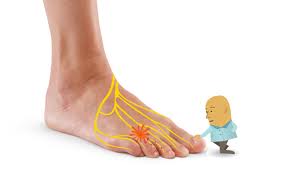Any type of pain can be unbearable. When one of your body parts suffers from this, your entire body already has a difficult time performing all the necessary tasks of the day. Nerve pain in feet  if only one of the most common and can be the most debilitating of all, considering that you may not be as mobile. When you have nerve pain in feet, it’s like someone is pricking you with needles. If you fail to manage this type of pain, you may end up being controlled by it. You won’t be able to do the needed chores like getting groceries or getting the morning paper. When the bed cover brushes your feet or when you wear socks, you will have that burning, excruciating pain. There are many people who suffer from nerve pain in feet and are not able to work consistently or get a good night’s rest.
Management of nerve pain in feet has to be done for you to take full control. You have to keep in mind that you have to participate well in your self care to benefit your entire health. When you do this, half of your struggle is already won. Some of the things that you can do are:
- Perform relaxation techniques
- Talk to your physician about pain management
- Ask for medications that target nerve pain in feet
- Exercise regularly
- Enjoy and get your family’s participation
Nerve pain in feet is not related to the muscle. As you know, it is deeper than that. It is often brought by a traumatic experience, an underlying disease, while muscle pain is often because of an injury. When there is trauma, the nerves experience damage .It can happen directly to the spine or some peripheral nerves of the body. Diseases like stroke or diabetes also result to nerve pain in feet.
Morton’s neuroma (interdigital neuroma, intermetatarsal neuroma, Morton’s metatarsalgia, entrapment neuropathy, or perineural fibrosis) is known to be one of the causes of nerve pain in feet. If you have a stabbing, sharp pain in your feet and this feels better when you massage your feet or stop taking steps or walking for a while. Morton’s neuroma may indeed sound intimidating or much like a very fatal disease but it is very treatable and considered as benign. This is a condition wherein the nerve thickens or enlarges. It is usually between your 3rd and 4th toes (3rd interpace), which is usually followed by pain between your 2nd and 3rd toes (2nd interspace). It is rare for Morton’s neuroma to affect the 1st and the 4th interspaces. Here are some of the facts about Morton’s neuroma and nerve pain in feet:
1. Causes
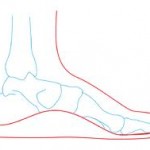 Nerve pain in feet brought on by Morton’s neuroma is caused by nerve injury, from the damage to the heads of the metatarsals, the intermetatarsal bursa, or the transverseintermetatarsal ligament. These affected structures can injure or compress the nerve, resulting to swelling and functional damage. If the nerve compression continues, the nerve gets to perform self repair with the help of the surrounding fibrous tissue. This repair leads to the nerve’s thickening and enlargement. The injury that causes this nerve pain in feet can be acquired from an abnormal structure of the foot (overpronation, cavo varus, excessive dorsiflexion, and hypermobility).
Nerve pain in feet brought on by Morton’s neuroma is caused by nerve injury, from the damage to the heads of the metatarsals, the intermetatarsal bursa, or the transverseintermetatarsal ligament. These affected structures can injure or compress the nerve, resulting to swelling and functional damage. If the nerve compression continues, the nerve gets to perform self repair with the help of the surrounding fibrous tissue. This repair leads to the nerve’s thickening and enlargement. The injury that causes this nerve pain in feet can be acquired from an abnormal structure of the foot (overpronation, cavo varus, excessive dorsiflexion, and hypermobility).
2. Symptoms
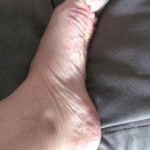 Some of th esyptoms of nerve pain in feet are tingling sensation, throbbing pain, shooting pain, sharp pain, stabbing pain, burning sensation, cramping, numbness, and a sensation that feels like you are stepping on something. The symptoms may be managed by foot massage or taking your footwear off.
Some of th esyptoms of nerve pain in feet are tingling sensation, throbbing pain, shooting pain, sharp pain, stabbing pain, burning sensation, cramping, numbness, and a sensation that feels like you are stepping on something. The symptoms may be managed by foot massage or taking your footwear off.
3. Diagnosis
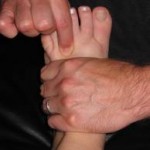 The foot doctor or podiatrist will ask you a series of questions about your nerve pain in feet. A physical exam will be performed on you. One of the diagnostic tests is the web space compression test wherein the metatarsals are squeezed together using an entire hand and the index finger and thumb of the other hand. This compression was aimed at producing the signs and symptoms. Mulder’s click (palpable click) is also common. Tinel’s sign is also a result of this test. This sign is described as the pain that shoots to the toes. Another test, Gauthier’s test, is a test that also involves the squeezing of the metatarsals and maneuvering them upwards and downwards for about thirty seconds.
The foot doctor or podiatrist will ask you a series of questions about your nerve pain in feet. A physical exam will be performed on you. One of the diagnostic tests is the web space compression test wherein the metatarsals are squeezed together using an entire hand and the index finger and thumb of the other hand. This compression was aimed at producing the signs and symptoms. Mulder’s click (palpable click) is also common. Tinel’s sign is also a result of this test. This sign is described as the pain that shoots to the toes. Another test, Gauthier’s test, is a test that also involves the squeezing of the metatarsals and maneuvering them upwards and downwards for about thirty seconds.
4. Treatment
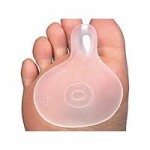 You can treat the nerve pain in feet by Morton’s neuroma by wearing deep and wide square-toe shoes. As much as possible avoid heels and wear metatarsal pads; swim; tape your metatarsals; perform ice treatment; take NSAIDs; get an arch support; and undergo physical therapy. A cortisone injection, alcohol injection and even surgery could also treat nerve pain in feet.
You can treat the nerve pain in feet by Morton’s neuroma by wearing deep and wide square-toe shoes. As much as possible avoid heels and wear metatarsal pads; swim; tape your metatarsals; perform ice treatment; take NSAIDs; get an arch support; and undergo physical therapy. A cortisone injection, alcohol injection and even surgery could also treat nerve pain in feet.
Morton’s neuroma can be prevented by avoiding activities and footwear that could aggravate the nerve pain in feet. Follow your podiatrist’s and therapist’s instructions and you will be on your way to fast recovery.
